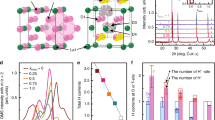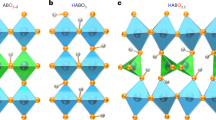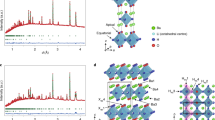Abstract
With strong reducibility and high redox potential, the hydride ion (H−) is a reactive hydrogen species and an energy carrier. Materials that conduct pure H− at ambient conditions will be enablers of advanced clean energy storage and electrochemical conversion technologies1,2. However, rare earth trihydrides, known for fast H migration, also exhibit detrimental electronic conductivity3,4,5. Here we show that by creating nanosized grains and defects in the lattice, the electronic conductivity of LaHx can be suppressed by more than five orders of magnitude. This transforms LaHx to a superionic conductor at −40 °C with a record high H− conductivity of 1.0 × 10−2 S cm−1 and a low diffusion barrier of 0.12 eV. A room-temperature all-solid-state hydride cell is demonstrated.
This is a preview of subscription content, access via your institution
Access options
Access Nature and 54 other Nature Portfolio journals
Get Nature+, our best-value online-access subscription
$29.99 / 30 days
cancel any time
Subscribe to this journal
Receive 51 print issues and online access
$199.00 per year
only $3.90 per issue
Buy this article
- Purchase on Springer Link
- Instant access to full article PDF
Prices may be subject to local taxes which are calculated during checkout




Similar content being viewed by others
Data availability
The data that support the findings of this study are available from the corresponding authors upon request. Source data are provided with this paper.
References
Verbraeken, M. C., Cheung, C., Suard, E. & Irvine, J. T. S. High H− ionic conductivity in barium hydride. Nat. Mater. 14, 95–100 (2015).
Kobayashi, G. et al. Pure H− conduction in oxyhydrides. Science 351, 1314–1317 (2016).
Huiberts, J. N. et al. Yttrium and lanthanum hydride films with switchable optical properties. Nature 380, 231–234 (1996).
van Vucht, J. H. N., Kuijpers, F. A. & Bruning, H. C. A. M. Reversible room-temperature absorption of large quantities of hydrogen by intermetallic compounds. Philips Res. Repts. 25, 133–140 (1970).
Vajda, P. in Handbook on the Physics and Chemistry of Rare Earths, Vol. 20 (eds Gschneidner, K. A. & Eyring, L.) 207–291 (Elsevier Science B. V., 1995).
Bachman, J. C. et al. Inorganic solid-state electrolytes for lithium batteries: mechanisms and properties governing ion conduction. Chem. Rev. 116, 140–162 (2016).
Zhang, Z. et al. New horizons for inorganic solid state ion conductors. Energy Environ. Sci. 11, 1945–1976 (2018).
Duan, C. et al. Readily processed protonic ceramic fuel cells with high performance at low temperatures. Science 349, 1321–1326 (2015).
Ngene, P. et al. Seeing hydrogen in colors: low-cost and highly sensitive eye readable hydrogen detectors. Adv. Funct. Mater. 24, 2374–2382 (2014).
Rettie, A. J. E. et al. A two-dimensional type I superionic conductor. Nat. Mater. 20, 1683–1688 (2021).
Jun, K. et al. Lithium superionic conductors with corner-sharing frameworks. Nat. Mater. 21, 924–931 (2022).
Ubukata, H. et al. Anion ordering enables fast H− conduction at low temperatures. Sci. Adv. 7, eabf7883 (2021).
Takeiri, F. et al. Hydride-ion-conducting K2NiF4-type Ba–Li oxyhydride solid electrolyte. Nat. Mater. 21, 325–330 (2022).
Fukui, K., Iimura, S., Iskandarov, A., Tada, T. & Hosono, H. Room-temperature fast H− conduction in oxygen-substituted lanthanum hydride. J. Am. Chem. Soc. 144, 1523–1527 (2022).
Udovic, T. J., Huang, Q., Karmonik, C. & Rush, J. J. Structural ordering and dynamics of LaH3−x. J. Alloy. Compd. 293–295, 113–117 (1999).
den Broeder, F. J. A. et al. Visualization of hydrogen migration in solids using switchable mirrors. Nature 394, 656–658 (1998).
van der Voort, E. & Guyot, P. On the electrical resistivity by scattering on metallic grain boundaries. Phys. Stat. Sol. B 47, 465–473 (1971).
Arenas, C., Henriquez, R., Moraga, L., Muñoz, E. & Munoz, R. C. The effect of electron scattering from disordered grain boundaries on the resistivity of metallic nanostructures. Appl. Surf. Sci. 329, 184–196 (2015).
Lu, L., Shen, Y., Chen, X., Qian, L. & Lu, K. Ultrahigh strength and high electrical conductivity in copper. Science 304, 422–426 (2004).
Villanueva-Cab, J., Jang, S., Halverson, A. F., Zhu, K. & Frank, A. J. Trap-free transport in ordered and disordered TiO2 nanostructures. Nano Lett. 14, 2305–2309 (2014).
Sondheimer, E. H. The mean free path of electrons in metals. Adv. Phys. 1, 1–42 (1952).
Mayadas, A. F. & Shatzkes, M. Electrical-resistivity model for polycrystalline films: the case of arbitrary reflection at external surfaces. Phys. Rev. B 1, 1382–1389 (1970).
Munoz, R. C. & Arenas, C. Size effects and charge transport in metals: quantum theory of the resistivity of nanometric metallic structures arising from electron scattering by grain boundaries and by rough surfaces. Appl. Phys. Rev. 4, 011102 (2017).
Guo, X. & Maier, J. Grain boundary blocking effect in zirconia: a Schottky barrier analysis. J. Electrochem. Soc. 148, E121–E126 (2001).
Thompson, E. L., Capehart, T. W., Fuller, T. J. & Jorne, J. Investigation of low-temperature proton transport in Nafion using direct current conductivity and differential scanning calorimetry. J. Electrochem. Soc. 153, A2351–A2362 (2006).
Schöllhammer, G., Herzig, P., Wolf, W., Vajda, P. & Yvon, K. First-principles study of the solid solution of hydrogen in lanthanum. Phys. Rev. B 84, 094122 (2011).
Majer, G., Kaess, U. & Barnes, R. G. Model-independent measurements of hydrogen diffusivity in the lanthanum dihydride-trihydride System. Phys. Rev. Lett. 83, 340–343 (1999).
He, X., Zhu, Y. & Mo, Y. Origin of fast ion diffusion in super-ionic conductors. Nat. Commun. 8, 15893 (2017).
Uchida, H., Huang, Y. C., Tada, M. & Fujita, K. The phase equilibria of La-H and Sm-H systems. Z. Phys. Chem. 114, 51–58 (1979).
Conder, K. & Kaldis, E. High accuracy volumetric determination of hydrogen in rare earth hydrides. J. Less-Common Met. 146, 205–211 (1989).
Kresse, G. & Joubert, D. From ultrasoft pseudopotentials to the projector augmented-wave method. Phys. Rev. B 59, 1758–1775 (1999).
Kresse, G. & Hafner, J. Ab initio molecular dynamics for liquid metals. Phys. Rev. B 47, 558–561 (1993).
Blöchl, P. E. Projector augmented-wave method. Phys. Rev. B 50, 17953–17979 (1994).
Perdew, J. P., Burke, K. & Ernzerhof, M. Generalized gradient approximation made simple. Phys. Rev. Lett. 77, 3865–3868 (1996).
Perdew, J. P., Burke, K. & Ernzerhof, M. Generalized gradient approximation made simple. Phys. Rev. Lett. 78, 1396–1396 (1997).
Monkhorst, H. J. & Pack, J. D. Special points for Brillouin-zone integrations. Phys. Rev. B 13, 5188–5192 (1976).
Henkelman, G., Uberuaga, B. P. & Jónsson, H. A climbing image nudged elastic band method for finding saddle points and minimum energy paths. J. Chem. Phys. 113, 9901–9904 (2000).
Acknowledgements
This work was jointly supported by the National Key Research and Development Program of China (grant no. 2021YFB4000602), the National Natural Science Foundation of China (grant nos. 21988101 and 22279130), Youth Innovation Promotion Association CAS (grant no. 2019189) and the Liaoning Revitalization Talents Program (grant no. XLYC2002076).
Author information
Authors and Affiliations
Contributions
P.C. conceived the project. W.Z., J.C. and S.W. synthesized the materials, performed the electrochemical experiments and analysed the data. A.W. performed the calculations. Y.X. collected and analysed the NPD results. Q.J. performed the HRTEM measurements. H.C. and P.C. supervised the study. W.Z., J.G., T.H., H.C. and P.C. wrote and revised the manuscript. All co-authors discussed and analysed the results.
Corresponding authors
Ethics declarations
Competing interests
The authors declare no competing interests.
Peer review
Peer review information
Nature thanks Ryan O'Hayre and the other, anonymous, reviewer(s) for their contribution to the peer review of this work.
Additional information
Publisher’s note Springer Nature remains neutral with regard to jurisdictional claims in published maps and institutional affiliations.
Extended data figures and tables
Extended Data Fig. 1 Sample preparation and composition.
a, The airtight ball milling vessel and operating system for sample preparation. The vessel can be pressurized to over 30 bar (H2) and keep airtight. For each operation the gas line will be purged by H2 gas followed by vacuum-pumping for 3 times. b, ICP-OES results of LaHx samples ball milled for different periods of time in a stainless steel vessel. c, H contents of REHx. The H contents were determined by isothermal dehydrogenation of LaHx at 550 °C (De-method) and acidolysis of REHx using hydrochloric acid solution (Re-method). The error of H contents determined here is around ± 0.02.
Extended Data Fig. 2 Morphology, porosity and BET areas of LaHx samples.
a, BET curves of the BM-LaHx and the BM-LaHx-700. b, Dimensions and porosity of tableted samples for conductivity measurements. The porosity was calculated by ratios of measured and theoretical densities of the samples. The surface areas of these two samples are small. In addition, sintering at 700 °C further reduced the surface area of LaHx. The samples were pressed into tablets at 500 MPa before the tests. c, SEM image of the BM-LaHx-700. The particle sizes range from 0.1 μm to 1 μm. Compared with the BM-LaHx sample (Fig. 1d), the high temperature sintering does not bring significant change to the size and morphology of those LaHx particles. d, HRTEM image of the BM-LaHx. e, HRTEM image of the BM-LaHx-700. The BM-LaHx contains smaller grains with sizes around 10 nm and abundant defects including grain boundaries, distorted and amorphous regions. The Pnma lattices (d(111) = 0.300 and d(121) = 0.215 nm) are present. The grains with d = 0.294 nm and 0.308 nm may be due to lattice deformation. The BM-LaHx-700 has much bigger crystalline grains, showing that high-temperature treatment improves crystallinity, while discrete domains with boundaries are present albeit less than that in the BM-LaHx. * The value is close to the limit of detection of the instrument.
Extended Data Fig. 3 Structure of the BM-LaDx-700 sample.
a, Crystal structure of the BM-LaDx-700. b, Refined results on the NPD pattern. Unit cell: Cubic \({Fm}\bar{3}m\), a = 5.62077 Å, Rp = 5.96%, Rwp = 7.69%, Rexp = 4.10%.
Extended Data Fig. 4 DC polarization curves of the BM-LaHx and LaHx-P-700 samples at –40 °C.
The work voltage is 100 mV and the dimension of the tableted samples is 5 mm in diameter and 1.5 mm thick.
Extended Data Fig. 5 The effect of oxygen on the electronic conductivity of the BM-LaHx sample.
The effect of oxygen on the electronic conductivity of the BM-LaHx was investigated by purposely pulsing O2 to the sample. Each time ca. 9 ml 1% O2/Ar (equivalent to ca. 0.02 mol O per mol LaHx) was pulsed into the sample chamber. The electronic conductivity of the sample was monitored. It is notable that the σe of the sample first rises by ca. 10 folds, then gradually decrease with more O2 pulsed in. Such results show that slight oxygen contamination enhances the electron conduction in the BM-LaHx. Therefore, it is unlikely that the oxygen contamination accounts for the suppression of electronic conductivity in the BM-REHx.
Extended Data Fig. 6 H-D exchange reaction over the BM-LaHx.
a, H-D exchange on the BM-LaHx. The temperature was fixed at 25 °C. D2 or H2 with a flow rate of 30 mL/min was fed to the sample alternatively. HD signal (m/z = 3) was monitored by a mass spectrometer. The H-D exchange reaction can take place repeatedly by feeding H2 and D2 alternatively. Each exchange cycle can be finished within 20 min showing facile H2/D2 dissociation at the surface and H–/D– migration in the lattice of the BM-LaHx at ambient temperature. b, TPD-MS curves of the BM-LaHx after treated in D2. The main product is D2, showing that nearly all octahedral H atoms of BM-LaHx have been replaced by D at room temperature. These results evidence facile H–/D– ion migration in the lattice of the BM-LaHx at ambient temperature.
Extended Data Fig. 7 EIS plots of the ball milled samples in the temperature range of –40 to 20 °C.
a, EIS plots of the BM-LaHx. b, EIS plots of the BM-LaHx-700. Samples were first cooled at −40 °C and then tested at 10 °C interval. Measurements were performed after temperature was stabilized at each point for one hour. The EIS plots of the BM-LaHx at lower temperatures are made up of a circle and a spike. For those of the BM-LaHx-700, the circle related to diffusion is absent, showing a fast diffusion process.
Extended Data Fig. 8 H– diffusivity in LaHx samples.
a, H-D exchange measurements over the BM-LaHx-700 and the LaHx-P-700 samples. Temperature was fixed at 100 °C. D2 or H2 with a flow rate of 30 mL/min was fed to the sample alternatively. HD signal (m/z = 3) was monitored by a mass spectrometer. 200 mg sample was tableted (10 mm in diameter and ~0.5 mm thick) and sintered for 10 h at 700 °C to improve its density. b, The integral peak areas of each H-D exchange. It can be inferred that H– diffusivity in BM-LaHx-700 and the LaHx-P-700 is almost the same because of the similar peak area. Using the Fick’s First Law and taking into account the steady-state diffusion with a constant concentration gradient (dC/dx ≈ ΔC/h, ΔC is the concentration difference of two sides of the pellet, h is the thickness), in case that all the octahedral H in LaHx are replaced by D in each H-D exchange cycle, the value of diffusivity (D) can be estimated by the equation D = h2/3t, t is the time for each cycle (~10 min). D is about 1.4*10−6 cm2/s at 100 °C, which is similar to the reported value (1.0*10−6 cm2/s) determined by PFG-NMR27. Assuming the carrier (H– or vacancy) concentration is 11.6/u.c. (the highest situation: all H– in LaHx were accounted) or 0.4/u.c. (the lowest situation: only H vacancies in LaHx were accounted), the σi estimated is in the range of 0.01-0.3 S/cm for LaHx at 100 °C. Our experimental value (σi = 0.08 S/cm for the BM-LaHx-700 at 100 °C) is within that range.
Extended Data Fig. 9 The vacancy configurations and energies of La108H322.
a,b,c, Three arrangements with relatively low energies. The cyan, white and green spheres represent La, H and octahedral vacancy, respectively. d, The 5 states with relatively low energies for the vacancy configurations of La108H322.
Extended Data Fig. 10 XRD patterns of electrode materials collected after discharge of the all-solid-state hydride cell Ti / BM-LaHx / TiH2.
Orange ticks: LaHx. Blue ticks: Ti. Cyan ticks: TiH2. Black line: anode material after discharge. It contains the α-phase of TiHx showing the hydriding of Ti. Pink line: cathode materials after discharge. It shows a slight shift of the TiH2 diffraction peaks to higher angles. The changes of diffraction patterns of the anode and cathode materials after discharge indicate H– migration from TiH2 to Ti.
Source data
Rights and permissions
Springer Nature or its licensor (e.g. a society or other partner) holds exclusive rights to this article under a publishing agreement with the author(s) or other rightsholder(s); author self-archiving of the accepted manuscript version of this article is solely governed by the terms of such publishing agreement and applicable law.
About this article
Cite this article
Zhang, W., Cui, J., Wang, S. et al. Deforming lanthanum trihydride for superionic conduction. Nature 616, 73–76 (2023). https://doi.org/10.1038/s41586-023-05815-0
Received:
Accepted:
Published:
Issue Date:
DOI: https://doi.org/10.1038/s41586-023-05815-0
This article is cited by
-
Light-driven ammonia synthesis under mild conditions using lithium hydride
Nature Chemistry (2024)
-
A simple path to ambient temperature ionic H− superconductors
Science China Chemistry (2024)
-
Percolation-induced resistivity drop in lutetium dihydride with controllable electrical conductivity over six orders of magnitude
Science China Physics, Mechanics & Astronomy (2023)
Comments
By submitting a comment you agree to abide by our Terms and Community Guidelines. If you find something abusive or that does not comply with our terms or guidelines please flag it as inappropriate.



